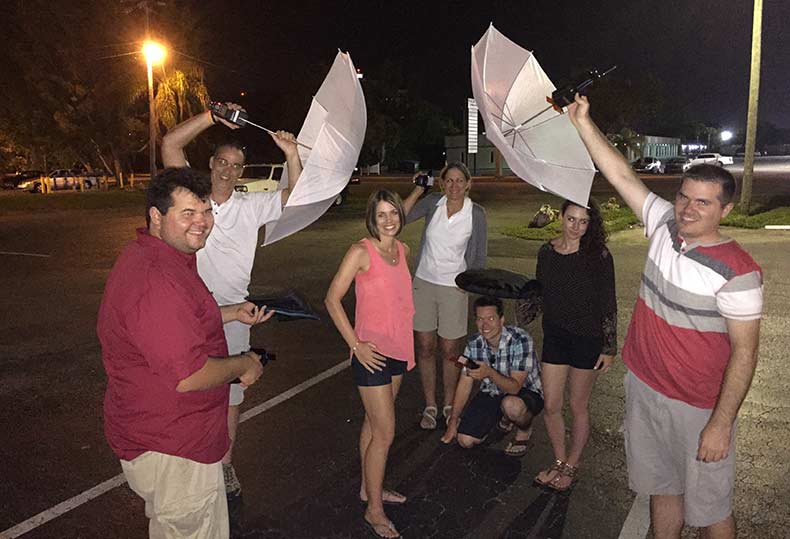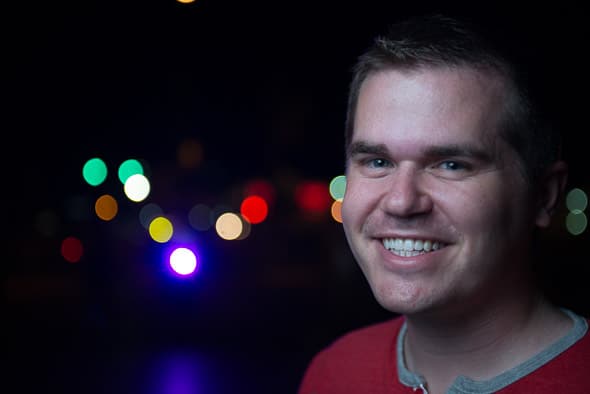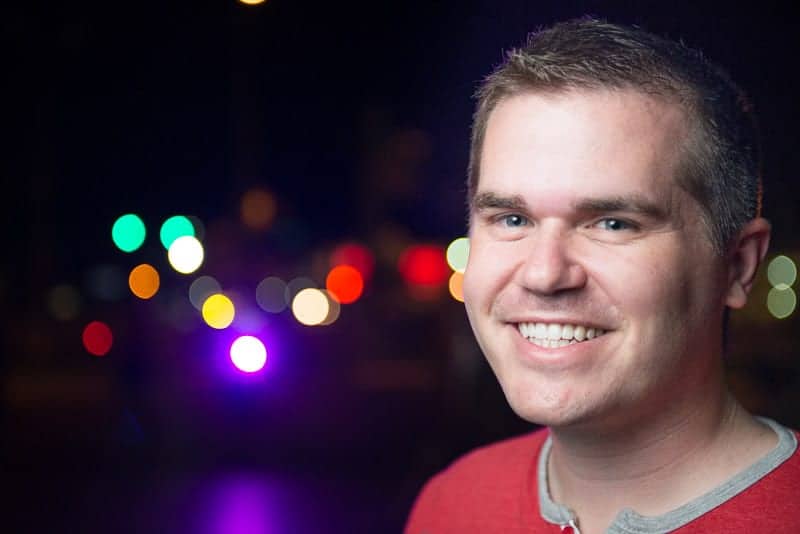If you feel like your portrait photography has become stale, then a night portrait is an excellent way to spice things up.
This last week I was in Southwest Florida holding a completely free photography workshop for readers of the site. I always share step-by-step tutorials like this in my free “Behind the Photos” newsletter but I decided to put this one on the site as well.
How to Make Bokeh Bursts of Light at Night
Creating the beautiful circles of light in the background of a night portrait isn’t complicated, but it will require a bit of understanding of depth-of-field.
The light bursts are simply city and street lights in the distance, which are put so far out of focus that they become these beautiful light bursts.
Simply using a low f-stop will help, but you’ll need to do more to make the lights larger in the frame. There are three more ways to create shallow depth of field: (1) Use a long focal length, (2) place the subject physically close to the lens, and (3) leave a long distance between the model and the lights in the background.
My Camera Settings
Camera: Nikon D800
Lens: Nikon 24-70mm f/2.8 lens
Focal length: 70mm
Shutter speed: 1/100 (Needs to be under 1/200 for the flash sync speed)
ISO: 1,000
Aperture: f/2.8

Adding Flash
Flash photography always looks stunning at night, when the flash is not competing with any ambient light.
The way I set up the flash for the self-portrait above is to simply use one simple $70 manual speedlight flash shooting through a cheap $10 white shoot through umbrella.
The flash was placed to camera left and slightly higher than my eyeline. Because it was so dark outside and our camera settings were gathering so much light, the flash was on very low power (1/16 if my memory serves me correctly).
Enhancing the Bokeh
If you’re shooting in a downtown area with lots of tail lights and lights from signs and stores, you’ll get plenty of light bursts to make a nice background.
When we took the picture above, we were in a darker area of the city in the parking lot of our hotel. So we didn’t get as many lights as we wanted.
To enhance the background, 5 or 6 of us grabbed our cell phones and turned on the flashlight apps. We then walked about 15 yards behind the model and placed a colored gel over our cell phone flashes to color the light. This provided enough extra bursts of light to add interest.

The Original, Unretouched Photo
I always share the original, unretouched photo in my free Tuesday “Behind the Photos” newsletter, and the readers of the site always tell me they appreciate seeing the photo straight out of the camera so they can know how to do the post-processing as well.
The post-processing of this photo was quite simple. All I did was:
- Bring up the shadows slider in Lightroom so that my hair stood out from the background and wasn’t so dark.
- I copied and pasted some of the bokeh bursts so that there would be more light spots. There weren’t quite enough of them for my taste.
The Step-by-Step
Step 1: Wait for night time. This works best when it’s completely dark.
Step 2: Place your subject far away from the lights from the street. If there aren't enough city lights in the background, you could place a few flashlights in the distance shining toward the camera.
Step 3: Minimize your depth of field by using a wide aperture, and stand close to the model and use a reasonably long focal length.
Step 4: The last step is to add a flash. For this portrait, we simply used a $70 manual flash and fired it through a $10 white umbrella that someone held above me and to the side of the camera. That's it!


Thank you for a simple, and yet awesome little tutorial! I loved it!
Great tutorial! Thank you for providing the camera settings as well. So many pros out there hold on to that info as if it was a state secret, but knowing what your settings were helps us to at least have a solid starting point!
Hi Jim,
I’m sorry but this is not a great photo. The original photo is underexposed. Yes, adjusting it Lightroom does help a bit but even after the adjustments there’s too much of a highlight glow on the forehead, I feel it could be sharpen that it is and the bokeh lights to right beside your ear are distracting.
My biggest problem is that the approach is still to take the picture and then fix it in Lightroom or Photoshop. These tool are great but it shouldn’t take away from the fact that you need to get the exposure correct from the start. Photography should be about using the tools at hand (camera and flash) to get a correctly exposed photo, not about playing with external tool after the fact to make up for shortcomings in the way you took the original photo.
Feel free to disagree with me. Perhaps I’m too old school but there’s still too much reliance of tools rather than the basics and fundamentals of photography to produce correctly exposed images.
Will, you said “Photography should be about using the tools at hand (camera and flash) to get a correctly exposed photo, not about playing with external tools…”
I’m sorry, but what makes you think you are the person to decide how everyone should make their art?
You’re welcome to use or not use whatever tools you choose. You’re not welcome to put other people’s work down because they aren’t doing it “right.” It’s art. Individual choices and preference is kinda the whole point!
Always enjoy your topics and how you explain things. I am always working on this bokeh,
Jim… thanks for this great tutorial.. its very creative and motivational.. make me want to get out and try that (soon as our mountains of snow are gone 🙂 Since I’ve recently been experimenting with off camera flash and umbrellas this is perfect for me !
In response to Will’s comment above…. while I respect his ability to get it ‘right in camera’ I have to agree when he says that notion is a bit ‘old school’ .. I got into photography late in life .. when the digital era arrived and while I can get it right in camera I also love the post processing with my Lightroom and Photoshop programs. There have been times I’ve managed to save some shots that might have otherwise landed in the trash. And it gives me yet another way to be creative and put my personal style on any photo I take. I challenge Will to step outside his comfort zone and give it a try.. you never know what you might come up with Will 🙂
Respectfully yours ….
hey Jim thanks for the nice tutorial ..it was so clearly stated and hopefully will try tonight.